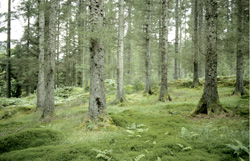Summary
Summary
 This project aims to increase the economic value of future Sitka spruce plantations substantially by using new breeding techniques to select outstanding rare individuals combining high growth rate with good timber qualities. Selection will be made at a very early age based on DNA markers found to be well correlated with later rotation performance.
This project aims to increase the economic value of future Sitka spruce plantations substantially by using new breeding techniques to select outstanding rare individuals combining high growth rate with good timber qualities. Selection will be made at a very early age based on DNA markers found to be well correlated with later rotation performance.
Research objectives
- Development of ‘Genomic Selection’ in Sitka spruce
- Development of DNA markers
- Early selection for growth rate and timber stiffness based on markers well correlated with later field performance
- Reduction of rotation lengths
- Increasing timber quality
- Massive increase in the economic benefits of growing Sitka spruce in Britain
- Shortening the time between selection in the lab based on the new DNA markers and delivery to the field of improved material.
Results so far
No results at the moment.
The first task is to associate DNA markers with certain tree characteristics measured in the field. Two existing 22-year-old field trials have been identified as perfect for this job; one in Brecon Forest and a sister experiment involving the same parents and families replicated in Kintyre Forest.
Status
Contract started 1st July 2017 and ran until 30 June 2020.
First trees were felled in Brecon, in mid-summer with the co-operation of Natural Resources Wales. The Kintyre site was felled in early autumn. A total of 1,400 trees will be measured in detail with samples returned to Northern Research Station for detailed analysis of growth rate and timber quality in early 2018. Association between DNA markers and phenotypic characteristics will be carried out by Oxford University. Roslin Institute will estimate the breeding value of trees based solely on the DNA markers.
Funders and partners
Partners are:
Professor John MacKay from Oxford University
Professor John Woolliams from Roslin Institute
Forest Research colleagues are:
Dr Gustavo Lopez
Dr Joan Cottrell and Dr Stuart A’Hara
Sources of funding were:
Sources within the Forest Industry
Related publications
Fuentes-Utrilla P, Goswami C, Cottrell JE, Pong-Wong R, Law A, A’Hara S, Lee SJ, and Woolliams JA (2017). QTL analysis and genomic selection using RADseq derived markers in Sitka spruce: the potential utility of within family data. Tree Genetics and Genomes, 13:33. DOI: 10.1007/s11295-017-1118-z
General Content
What’s of interest
Developments in forest genomics in Britain
This article first appeared in the autumn 2017 issue of Chartered Forester, the magazine for members of the Institute of Chartered Foresters. It is reproduced by kind permission of the Institute. www.charteredforesters.org
